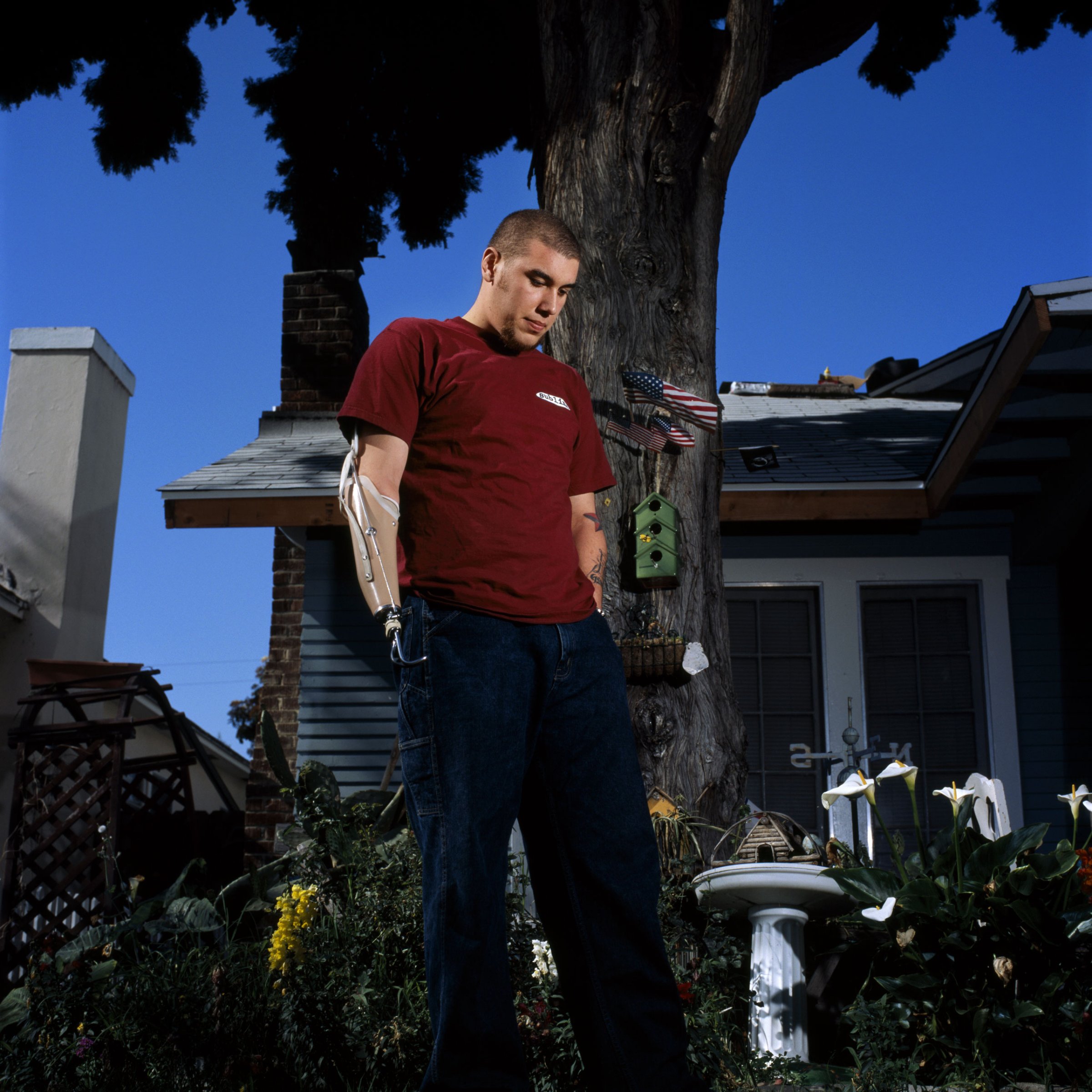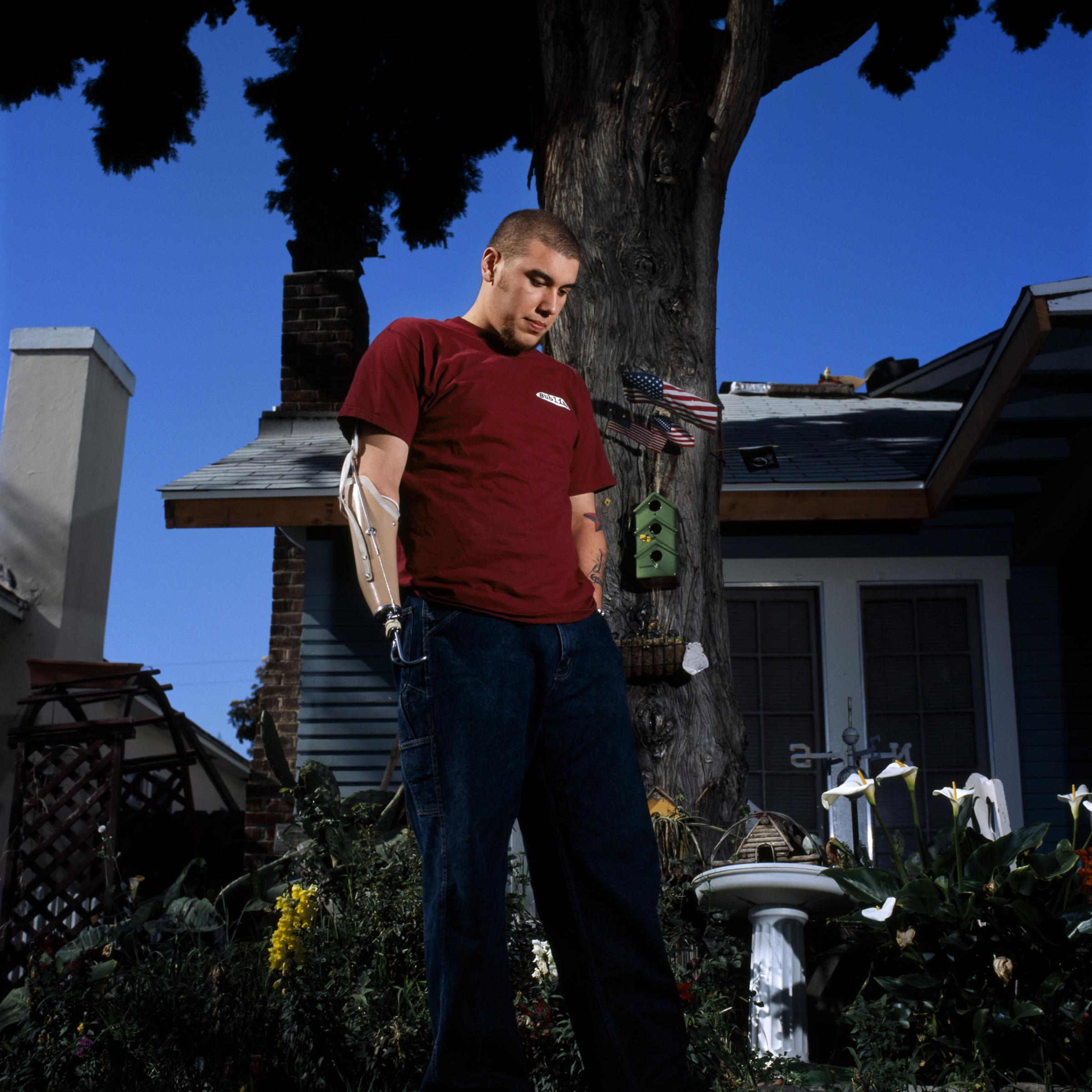
I was deeply disturbed at the media coverage of the Iraq War, especially in its early months. There were few-if any-images of human casualties, American or Iraqi. In my opinion, it was a sanitized view of the war and a hyped-up Hollywood version at the same time that played out on American television as breathless entertainment with screaming headlines like “Shock and Awe”, “The March to Baghdad” and “The Rescue of Jessica Lynch.” I thought I could add some complexity into the narrative by investigating what it meant to be wounded, who these troops were, what it meant to return home at such a young age and make the transition to disabled veteran.
One of the veterans I photographed was Robert Acosta, a 20-year-old ammunition specialist in the Army. In July 2003, he was riding in a Humvee with a friend near Baghdad International Airport when an Iraqi teenager threw a grenade into their vehicle. Robert tried to toss it out but it exploded in his hand, which permanently mangled his left leg and ripped off his right arm. He ended up in Walter Reed hospital in Washington D.C. where I met him in the fall of 2003. He was sitting in the prosthesis room, and a man was patiently painting hairlines on what would be his new right arm.
I tracked him down several months later at his home then in Santa Ana, Calif. Robert was struggling with the alienation of being back home, the pain of losing limbs and post traumatic stress. He was beginning to question the reasons for going to war and the legitimacy of the mission in Iraq. Later on, he would encounter problems with his medical benefits and started to speak out about veteran issues.
At first, I had trouble getting my images published editorially in the United States, and that left me quite frustrated so I sought out other options. When the Open Society Foundation proposed their first Audience Engagement Grant in 2005, I applied and invited Robert to come with me to talk to high school students. We traveled to California, Hawaii, Wisconsin and Illinois. We also went to Germany together and visited his old army base in Hanau, and then opened exhibitions in Heidelberg and Freiburg. We made a giant billboard with Robert’s picture and placed it in Albuquerque, N.M.
He was a great partner, and I know it wasn’t easy for him to stand in front of audiences and retell his story over and over again. Sometimes when I would play the video I made of the soldiers, he would walk out of the room because it bothered him to keep seeing it. At some of the high schools, students cried, and others were confused as they were in the process of enlisting into the military. But he made it through several trips because he was determined to show that war wasn’t the glamorized view that you got on television, that it was far more complex and that the needs of returning veterans were profound.
We didn’t have any metrics to measure the impact of these tours. Facebook and social media weren’t really up and going then. I measured the impact based on the looks on people’s faces, the questions they asked and the engagement in the room. I also received letters from students, and many emails, which I value greatly. The work also inspired other work by playwrights, painters and filmmakers, and a feature TV documentary based on the book was made.
Doing the work with Robert also reaffirmed the power of photography for me, which I had come to questions after years of publishing editorially with little awareness of how my images were being viewed and almost no control over the context in which they were appearing. It taught me that I had the power to take more control over my work and freed me to think bigger.
I continued to photograph veterans from the Iraq war for another eight years, and I became an expert on the subject. I realized how important it was to not just make a photograph, but to immerse myself in a subject so that I could represent the work and defend it. I approach all my projects this way now, with an eye towards collaboration and a goal of independence. It’s not easy in terms of funding, but I feel much more satisfied and I take my responsibility as a photographer much more seriously.
Nina Berman is an American documentary photographer with two monographs, Purple Hearts and Homeland. She is a member of NOOR photo agency and an associate professor at Columbia University Graduate School of Journalism.

More Must-Reads from TIME
- Donald Trump Is TIME's 2024 Person of the Year
- TIME’s Top 10 Photos of 2024
- Why Gen Z Is Drinking Less
- The Best Movies About Cooking
- Why Is Anxiety Worse at Night?
- A Head-to-Toe Guide to Treating Dry Skin
- Why Street Cats Are Taking Over Urban Neighborhoods
- Column: Jimmy Carter’s Global Legacy Was Moral Clarity
Contact us at letters@time.com